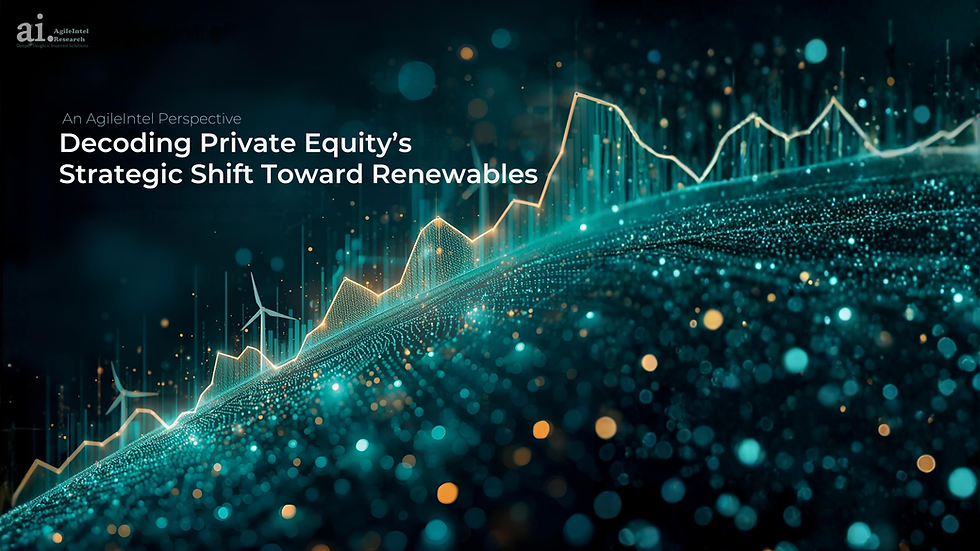Private Equity Fund Trends in Renewables: Deciphering Capital Flows and Strategic Moves in 2025
- AgileIntel Editorial

- Nov 4
- 4 min read

The global energy landscape is experiencing a historic transformation. The accelerating shift from fossil fuels to renewable energy is driven not just by sustainability mandates, but also by significant financial opportunity.
Private equity (PE) is playing an increasingly strategic role in this transition, moving beyond financing to drive operational efficiency and innovation in renewable assets worldwide. The convergence of policy incentives, declining technology costs, and shifting investor priorities is enabling PE to expand its footprint in renewables with greater sophistication.
Macro Landscape: PE’s Strategic Recalibration in Renewables
While 2024 saw global PE fundraising fall by approximately 24% year-on-year for traditional buyout and growth funds, capital deployment into infrastructure, particularly renewables, continued to accelerate. Global investment in renewables and clean energy projects reached nearly US$375–390 billion in the first half of 2025. McKinsey’s 2025 report on the international private market predicts double-digit growth in infrastructure deal value, particularly in energy transition assets. Dry powder reserves in PE infrastructure strategies have experienced a modest contraction in 2025, reflecting a more aggressive stance by funds seeking long-duration, stable-yield assets.
Rather than focusing on merchant renewable power, private equity’s strategy has shifted toward assets with offtake certainty, such as utility-scale PPAs, industrial decarbonization partnerships, and infrastructure embedded with advanced digital controls. Offshore wind, which attracted nearly US$37 billion in new asset finance in the first half of 2025, and small-scale solar have seen significant growth. Utility-scale solar and onshore wind saw a slowdown in asset financing. This trend reflects regulatory resets and pricing mechanisms in key geographies, including the US, Spain, and China.
Spotlight Case Studies: Platform Scaling, Risk Engineering, and Innovation
Amidst shifting capital flows and regulatory complexity, certain private equity players are setting clear benchmarks for success in renewable energy. Examining high-impact case studies reveals how market leaders are advancing platform scaling, risk management, and operational innovation. The following examples illustrate the diverse strategies PE firms are deploying to capture value and build future-ready energy portfolios.
Blackstone: Large-Scale Equity Investment in Invenergy Renewables Holdings
Blackstone invested US$1 billion in Invenergy Renewables Holdings in 2023 to support growth across its renewable energy portfolio, including solar, wind, battery storage, and transmission infrastructure in North America. This capital injection fuels the development of diversified clean energy assets, blending stable contracted revenues with strategic innovation in grid integration and flexibility.
KKR and TotalEnergies: Strategic North American Solar Partnership
In September 2025, KKR acquired a 50% stake in a 1.4 GW solar portfolio from TotalEnergies in the United States, in a transaction valued at US$1.25 billion. This portfolio comprises utility-scale solar assets spanning multiple states, supported by long-term power purchase agreements with high-credit-quality offtakers. The deal positions KKR as a leading player in the North American renewables market and underlines investor focus on scalable, contracted solar infrastructure for stable yield and inflation resilience.
Advanced Data Trends and Market Mechanics
Geographic Capital Flows: The EU-27 recorded robust growth in renewable investment, increasing by more than 45% in the first half of 2025 compared to the same period in 2024. The US experienced a decline of more than 30% in renewable PE deal activity due to a post-election pause and regulatory uncertainty surrounding federal tax credits. Southeast Asia and Latin America have posted their highest levels of PE investment in renewables to date. India added an estimated 16–18 GW of new auction-led solar and hybrid capacity in the first half of 2025.
Project Risk Engineering: Capital is increasingly flowing toward projects with shorter payback timelines and modular build-out flexibility. This trend is particularly evident in China’s residential solar market, where installations nearly doubled year-on-year, and in the rapid development of European floating offshore wind.
Returns and Cost Efficiency: According to IRENA’s 2024 report on renewable power generation costs, the global average levelized cost of solar PV is now over 50% below the parity of fossil fuels. While returns vary by structure and geography, utility-scale solar platforms commonly target unlevered IRRs in the low to mid-teens. Advances in storage technology enable PE to support synthetic baseload renewable energy portfolios.
Tech and AI Overlay: Leading asset managers are deploying predictive analytics and AI-enabled platforms to optimise yield, manage curtailment, and mitigate price volatility. This trend is boosting both plant uptime and offtake contract performance, especially in merchant-exposed markets.
Challenges and Strategic Reflections
A consultancy-grade view of renewable power in 2025 highlights persisting hurdles. Regulatory volatility is leading to higher dispersion in returns as markets, such as the US, confront shifting policy environments, while Europe benefits from greater regulatory alignment. Successful platform scaling now demands advanced operator capabilities, real-time analytics, and construction risk underwriting. This new environment significantly surpasses passive asset management. Many funds are also facing a growing backlog of unsold assets, which is pressuring exit multiples as valuations reset and credit markets tighten.
Outlook: The Rising Bar for Value Creation
Leading PE sponsors are evolving from traditional financial engineering to hands-on operational transformation. This includes integrating digital controls, forming demand-side partnerships, and deploying innovative fund structures. According to McKinsey, approximately one-third of limited partners surveyed in 2025 plan to increase allocations to PE, with special focus on infrastructure and energy transition vehicles.
PE’s influence in renewables is unmistakable and increasingly sophisticated. The ability to architect, optimise, and risk-balance complex energy systems is now a fundamental differentiator. Firms that blend platform growth, regulatory anticipation, and technological integration will set the pace for the next decade of energy transition investing.







Comments